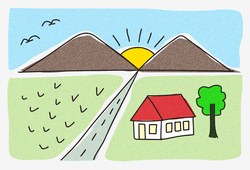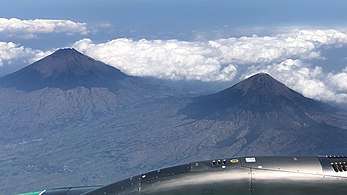Twin mountain drawing
A drawing of twin mountain (Indonesian: pemandangan gunung kembar "twin mountain view", pemandangan gunung legendaris "legendary mountain view") is a common drawing pattern made by Indonesian kindergarten and primary school students. The drawing most probably would be selected by students whenever their teacher tasked them to draw natural features.[1]

The drawing would always consists of twin mountain, sun, road, and rice field. Other objects usually added by students includes clouds, houses, trees, grasses, and a person.[2][3] The drawing shown children's tendencies to compose a symmetrical drawing of a non-symmetrical features, and also to imitate their peers.[4][2]
History

The template originates from Yogyakartan artist Tino Sidin, the host of a childrens drawing show Gemar Menggambar broadcast by state television TVRI in 1980s. One of the drawings made by Tino consisted of twin mountains and rice fields. Drawings made by Tino were proved so popular that Indonesian children began to imitate his drawing, and teachers used his drawings as reference for their students in the classroom.[5][6] Mount Sindoro and Mount Sumbing located in Central Java sometimes cited as the real-life example of the drawing.[7]
Criticism
Several critics argued that the twin mountain drawing frequently drawn by students highlighted existing issues on current situation and quality of education in Indonesia.
Indonesian teachers and schools are perceived as monotonous, as students almost unanimous decision to draw twin mountains showed that schools lacked action to promote diversity and creativity, and more actions should be done by teachers to promote creativity to their students.[8][3] The monotonous nature of schools causes students to be afraid to be different and forcing them to conform and draw the same imagery as their peers.[9]
The phenomenon also shown the dogmatic characteristics of teachers that always dictate and not open to other options made by their students, often allowing them to only follow what the teacher has made, despite personal experiences and openness to information sources should actually allow students to have imagery other than the twin mountain when asked to draw natural features.[10][1]
See also
- Cool S, a similar phenomenon of universally-drawn picture
References
- "Anak-anak yang Terpenjara di antara Dua Gunung :: SekolahSuper.com - Sekolahnya semua : orang tua, guru dan anak ." sekolahsuper.com (in Indonesian). Retrieved 2020-01-16.
- Kurniawan, Franky (2011). "Studi tentang gambar berpola gunung kembar pada hasil karya anak / Franky Kurniawan". Studi tentang gambar berpola gunung kembar pada hasil karya anak / Franky Kurniawan (in Indonesian). 2011 (2011): 1–99.
- Suwarna. 2008. Gejala-Gejala Karya Seni Lukis Anak-Anak TK dan Pembinaannya di Kecamatan Bantul. Universitas Negeri Yogyakarta, PDF
- Martono (2017). "Pembelajaran Seni Lukis Anak untuk Mengembangkan Imajinasi, Ekspresi, dan Apresiasi". Prosiding Seminar Nasional Pendidikan FKIP UNTIRTA (in Indonesian).
- Times, IDN; Revitasari, Febriyanti. "Tahu Gak Kenapa Kita Selalu Menggambar Pemandangan yang Sama? Ini Jawabannya!". IDN Times (in Indonesian). Retrieved 2020-01-16.
- Loop. "Kenapa Anak Kecil Suka Menggambar Gunung? Begini Penjelasannya! | Loop.co.id". loop.co.id (in Indonesian). Retrieved 2020-01-16.
- Okezone (2017-03-30). "Gunung Kembar Legendaris Ternyata Aslinya Gunung Susi! : Okezone Nasional". Okezone (in Indonesian). Retrieved 2020-01-16.
- Sianturi, Riyanthi (2019-02-28). "Menggambar Pemandangan dan Kreativitas yang Tenggelam dalam Keseragaman". Medium (in Indonesian). Retrieved 2020-01-17.
- Fadila, Yogie (2014-12-31). "Karena Kita Semua Pernah Menggambar Dua Gunung dengan Sawah dan Matahari: Bagaimana Sekolah Membunuh Bakat Kreatif Kita". Hipwee (in Indonesian). Retrieved 2020-01-16.
- Kompasiana.com. "Gunung, Matahari, Sawah dan Jalan Raya: Bukti Jiwa Seni yang Mati". KOMPASIANA (in Indonesian). Retrieved 2020-01-16.